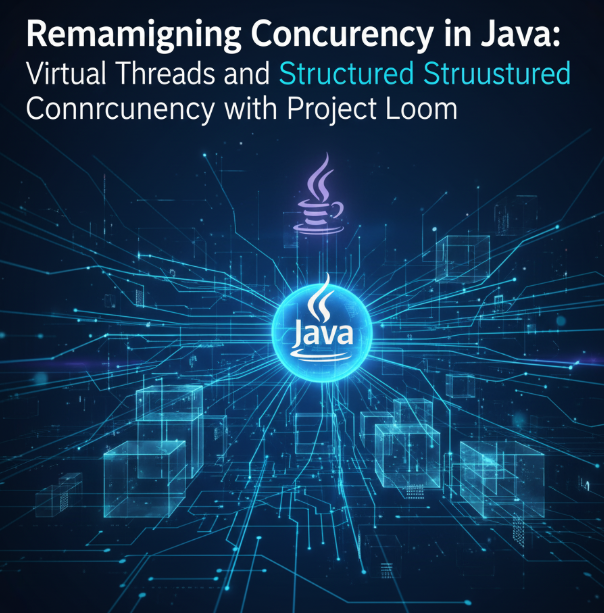The Java ecosystem is a testament to sustained innovation, a vibrant landscape that continuously evolves without sacrificing the stability and performance it’s renowned for. For developers, staying current isn’t just a recommendation; it’s a strategic advantage. The rapid six-month release cadence of the JDK, coupled with relentless progress in foundational frameworks like Spring and Jakarta EE, brings a steady stream of powerful features, performance enhancements, and new programming paradigms. From the game-changing concurrency models of Project Loom to the burgeoning field of AI integration with libraries like Spring AI, the platform is more dynamic than ever.
This article delves into the most significant recent developments shaping the world of Java. We’ll explore the upcoming features in JDK 22, unpack the practical impact of virtual threads, examine the latest advancements in the Spring ecosystem, and even venture into the exciting new frontiers of reactive programming and artificial intelligence. Whether you’re a seasoned architect, a mid-level developer, or just starting your Java journey, this comprehensive roundup will provide the insights and practical code examples you need to navigate the modern Java landscape effectively.
The Evolving Core: JDK 22 and the Future of Concurrency
The heart of the ecosystem is the Java Development Kit (JDK) itself, and its evolution dictates the capabilities available to every developer. With JDK 22 nearing its general availability, it brings a mix of preview features and finalized enhancements that refine the language and the JVM. This continuous improvement, particularly in areas like concurrency, is a cornerstone of modern Java news.
What’s New in JDK 22?
Each new JDK release brings a host of Java Enhancement Proposals (JEPs) to fruition. JDK 22 continues this trend, with several notable features. One particularly useful language enhancement, graduating from preview in JDK 22, is JEP 447: Statements before super(…). Previously, any statement in a constructor had to appear after the explicit `super(…)` or `this(…)` call. This often led to redundant code or the need for helper methods to prepare arguments for the superclass constructor.
Consider a scenario where you need to validate or transform a parameter before passing it to the superclass. Before JDK 22, you might have used a static helper method.
// The "Old" Way: Using a static helper method
public class EnhancedUser extends BaseUser {
public EnhancedUser(String name, String email) {
super(validateAndFormatEmail(email), name);
// Other initialization logic...
}
private static String validateAndFormatEmail(String email) {
if (email == null || !email.contains("@")) {
throw new IllegalArgumentException("Invalid email format");
}
return email.toLowerCase().trim();
}
}With JEP 447, this logic can be brought directly into the constructor, making the code more readable and self-contained. The rule is that any statements before `super()` cannot reference the instance being created.
// The "New" Way with JDK 22 (JEP 447)
public class EnhancedUser extends BaseUser {
public EnhancedUser(String name, String email) {
// Logic is now inline, before the super() call
if (email == null || !email.contains("@")) {
throw new IllegalArgumentException("Invalid email format");
}
String formattedEmail = email.toLowerCase().trim();
super(formattedEmail, name); // super() call is no longer the first statement
// Other initialization logic...
System.out.println("EnhancedUser created for: " + this.getName());
}
}
// Assume a simple BaseUser class exists
class BaseUser {
private String email;
private String name;
public BaseUser(String email, String name) {
this.email = email;
this.name = name;
}
public String getName() { return name; }
}Other significant features in JDK 22 include the second preview of Stream Gatherers (JEP 461) for creating custom intermediate stream operations, and the continued incubation of APIs from Project Panama and Project Valhalla, which promise to revolutionize how Java interacts with native code and optimizes memory layout.
The Loom Revolution: Virtual Threads in Practice
Finalized in Java 21, virtual threads from Project Loom are arguably the most impactful addition to the JVM in years. They represent a fundamental shift in Java concurrency news, enabling a simple, blocking, thread-per-request style of code to scale to millions of concurrent tasks. This is achieved by mapping lightweight virtual threads to a small number of heavyweight OS platform threads.
The practical difference is profound. A traditional approach for handling many I/O-bound tasks would involve a cached thread pool, which can quickly become a bottleneck. With virtual threads, the approach is much simpler and more scalable.

import java.time.Duration;
import java.util.concurrent.ExecutorService;
import java.util.concurrent.Executors;
import java.util.stream.IntStream;
public class VirtualThreadsDemo {
public static void main(String[] args) {
// Using the new ExecutorService factory for virtual threads
try (ExecutorService executor = Executors.newVirtualThreadPerTaskExecutor()) {
IntStream.range(0, 10_000).forEach(i -> {
executor.submit(() -> {
// Simulate a blocking I/O operation, like a network call
Thread.sleep(Duration.ofSeconds(1));
System.out.println("Task " + i + " completed on thread: " + Thread.currentThread());
// The output will show a mix of platform threads (e.g., ForkJoinPool-1-worker-1)
// running many different virtual threads.
});
});
} // executor.close() is called automatically, waiting for tasks to finish
}
}Running this code will demonstrate that even with 10,000 concurrent sleeping tasks, your application won’t create 10,000 OS threads. The JVM efficiently manages the underlying platform threads, “unparking” the virtual thread only when its blocking operation is complete. This makes writing high-throughput, concurrent applications significantly more straightforward, a major piece of Java performance news.
Enterprise Java Reimagined: Spring and Jakarta EE Updates
While the core JDK provides the foundation, frameworks like Spring and Jakarta EE provide the structure for building robust, enterprise-grade applications. Recent releases in this space have focused on embracing modern JDK features, improving developer experience, and catering to cloud-native architectures.
Spring Framework 6.1 and Spring Boot 3.2+
The Spring ecosystem continues its rapid pace of innovation. The latest stable lines, Spring Framework 6.1 and Spring Boot 3.2, are built on a Java 17 baseline, allowing them to fully leverage modern language features. A key theme in recent Spring news is the first-class support for virtual threads. You can now enable virtual threads for handling web requests with a simple configuration property in `application.properties`:
spring.threads.virtual.enabled=true
Another significant update is the introduction of the `RestClient`, a modern, fluent alternative to the classic `RestTemplate`. It offers a synchronous, blocking API with a functional style similar to the reactive `WebClient`.
import org.springframework.stereotype.Service;
import org.springframework.web.client.RestClient;
// Assuming this is part of a Spring Boot application with the web starter
@Service
public class ProductService {
private final RestClient restClient;
// The RestClient.Builder is auto-configured by Spring Boot
public ProductService(RestClient.Builder builder) {
this.restClient = builder.baseUrl("https://api.example.com").build();
}
public Product getProductById(String id) {
try {
return restClient.get()
.uri("/products/{id}", id)
.retrieve()
.body(Product.class);
} catch (Exception e) {
// Handle exceptions, e.g., 404 Not Found
return null;
}
}
}
// A simple record to hold the product data
record Product(String id, String name, double price) {}This new API simplifies HTTP communication, making code cleaner and more expressive. This is a prime example of the kind of developer-centric improvements found in the latest Spring Boot news.
Jakarta EE and Cloud-Native Standards
On the standards front, Jakarta EE continues to be the bedrock for many large-scale enterprise systems. The focus of Jakarta EE news is on providing a stable, vendor-neutral set of specifications for building cloud-native applications. Platforms like Payara, WildFly, and Open Liberty are driving this evolution by providing certified implementations. Jakarta EE 10 solidified the transition from the `javax.*` to the `jakarta.*` namespace and introduced the Core Profile, a subset of specifications aimed specifically at microservices. This allows for smaller, faster runtimes, which is critical in a containerized world.
Pushing the Boundaries: Reactive Programming and AI in Java
Beyond traditional enterprise applications, the Java ecosystem is also a fertile ground for cutting-edge paradigms. Reactive programming has matured into a mainstream approach for building resilient, scalable systems, and the new wave of AI integration is opening up exciting possibilities.
The Reactive Paradigm with Project Reactor

Reactive Java news revolves around building applications that are non-blocking and event-driven. This model excels at handling high loads with efficient resource usage, especially in microservice architectures that involve a lot of network communication. Project Reactor, the foundation of Spring WebFlux, is a leading library in this space. It provides two main types, `Mono` (for 0 or 1 items) and `Flux` (for 0 to N items), which represent asynchronous data streams.
Working with reactive streams involves composing a pipeline of operators that transform, filter, and combine data as it flows through.
import reactor.core.publisher.Flux;
import java.time.Duration;
public class ReactiveStreamExample {
public static void main(String[] args) {
Flux<String> userStream = Flux.just("Kevin", "Alice", "Ben", "Sarah", "Alex")
.delayElements(Duration.ofMillis(100)); // Simulate an async source
userStream
.map(String::toUpperCase) // Transform each name to uppercase
.filter(name -> name.startsWith("A")) // Filter for names starting with 'A'
.log() // Log events in the stream for debugging
.subscribe(
System.out::println, // onNext consumer
error -> System.err.println("An error occurred: " + error), // onError consumer
() -> System.out.println("Stream processing complete.") // onComplete runnable
);
// In a real app, you wouldn't block, but for this demo, we need to wait
// for the async stream to finish.
try {
Thread.sleep(2000);
} catch (InterruptedException e) {
e.printStackTrace();
}
}
}This declarative style can be a shift for developers used to imperative code, but it provides powerful tools for managing complex asynchronous workflows and backpressure.
Java Meets AI: Exploring Spring AI and LangChain4j
The most exciting recent trend is the integration of Generative AI into Java applications. Frameworks are emerging to abstract away the complexity of interacting with Large Language Models (LLMs). Spring AI is a new project from the Spring team that aims to apply Spring’s principles of inversion of control and dependency injection to the AI domain. It provides a consistent API for interacting with models from OpenAI, Azure, and others.
Similarly, LangChain4j is another powerful open-source library providing building blocks for AI applications. These tools handle prompt templating, model interaction, and parsing output, making it much easier to add AI features. While still in early stages, the Spring AI news points to a future where AI is a first-class citizen in enterprise Java.
Best Practices, Tooling, and Performance
A thriving ecosystem is not just about language features and frameworks; it’s also about the tools and practices that support developers.

Modern Build Tools and Testing
Build tools like Maven and Gradle continue to evolve, with recent Maven news highlighting improved build performance and better support for modern Java versions. In testing, the combination of JUnit 5 and Mockito remains the de facto standard. JUnit 5’s modular architecture and rich extension model provide immense flexibility, while Mockito excels at creating test doubles to isolate units of code for focused testing. Adhering to a robust testing strategy is a timeless piece of Java wisdom.
JVM Choices and Performance Tuning
The JVM itself is a critical component. Developers have a wide choice of OpenJDK distributions, including the Oracle JDK, Adoptium Temurin, Amazon Corretto, and Azul Zulu. Each offers different support models and performance characteristics. For top-tier performance, modern Garbage Collectors like G1 (the default) and ZGC (for low-latency) are essential. For diagnosing performance issues, especially in a world with virtual threads, tools like Java Flight Recorder (JFR) and Java Mission Control (JMC) are indispensable for gaining deep insights into application behavior with minimal overhead.
Conclusion: The Path Forward
The Java ecosystem is in a period of remarkable growth and modernization. The rapid release schedule of the JDK, anchored by Long-Term Support (LTS) versions like Java 17 and 21, provides a perfect balance of innovation and stability. Project Loom has fundamentally changed the game for concurrency, making it easier than ever to build highly scalable applications. The Spring Framework continues to set the standard for developer productivity, embracing core Java advancements and expanding into new domains like AI.
For developers, the key takeaway is clear: embrace the new. Experiment with the features in JDK 22, refactor a network-bound service to use virtual threads, build a sample application with Spring Boot 3.2’s `RestClient`, or even explore the basics of Spring AI. The platform is providing more powerful, expressive, and performant tools than ever before. By staying engaged and continuously learning, you can harness the full power of the modern Java ecosystem to build the next generation of resilient and intelligent applications.

